小学英语语法 介词和连词9教案资料
- 格式:doc
- 大小:297.00 KB
- 文档页数:6
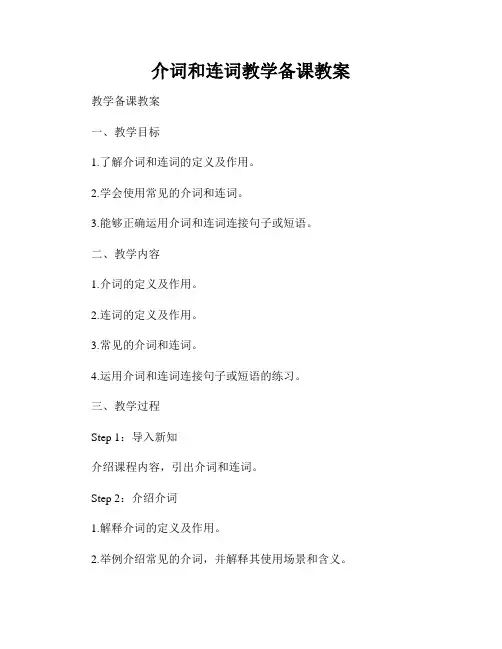
介词和连词教学备课教案教学备课教案一、教学目标1.了解介词和连词的定义及作用。
2.学会使用常见的介词和连词。
3.能够正确运用介词和连词连接句子或短语。
二、教学内容1.介词的定义及作用。
2.连词的定义及作用。
3.常见的介词和连词。
4.运用介词和连词连接句子或短语的练习。
三、教学过程Step 1:导入新知介绍课程内容,引出介词和连词。
Step 2:介绍介词1.解释介词的定义及作用。
2.举例介绍常见的介词,并解释其使用场景和含义。
3.让学生动手完成几个练习,以加深对介词的理解。
Step 3:介绍连词1.解释连词的定义及作用。
2.举例介绍常见的连词,并解释其使用场景和功能。
3.让学生动手完成几个练习,以加深对连词的理解。
Step 4:辨析介词和连词1.通过对比介词和连词的不同用法,引导学生理解二者之间的区别。
2.给出一些句子,让学生判断其中是否需要使用介词或连词,并解释理由。
Step 5:练习运用1.提供一系列句子,要求学生根据语境选择合适的介词或连词填空。
2.以小组为单位进行对答案的讨论和校对。
Step 6:达到教学目标帮助学生归纳总结介词和连词的用法,并检测他们对于介词和连词的掌握程度。
四、教学资源1.教材:提供介词和连词的定义和例句。
2.练习题:提供一系列练习题供学生练习。
五、教学评价1.观察学生对介词和连词的理解和掌握程度。
2.收集学生完成的练习题,进行评分。
六、教学拓展1.鼓励学生在实际应用中运用介词和连词,如在写作中使用正确的介词和连词连接句子。
2.提供更多的练习资源供学生巩固和拓展。
七、课后作业1.完成课堂练习题。
2.扩展练习:写一篇短文,使用适当的介词和连词来连接句子和段落。
八、板书设计介词连词- 定义和作用 - 定义和作用- 常见的介词 - 常见的连词九、教学反思通过本节课的教学,学生对介词和连词的理解程度较高,能够正确运用于句子和短文中。
在教学过程中,我注意到学生在练习中还存在一些困惑,下一次需要更多的练习和解惑互动。

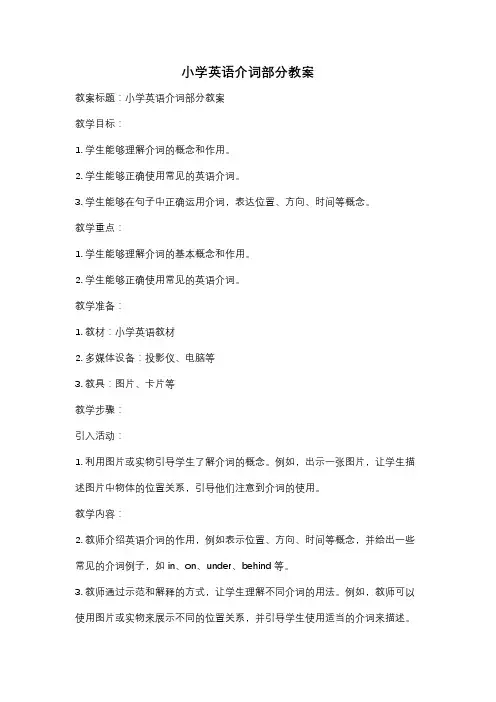
小学英语介词部分教案教案标题:小学英语介词部分教案教学目标:1. 学生能够理解介词的概念和作用。
2. 学生能够正确使用常见的英语介词。
3. 学生能够在句子中正确运用介词,表达位置、方向、时间等概念。
教学重点:1. 学生能够理解介词的基本概念和作用。
2. 学生能够正确使用常见的英语介词。
教学准备:1. 教材:小学英语教材2. 多媒体设备:投影仪、电脑等3. 教具:图片、卡片等教学步骤:引入活动:1. 利用图片或实物引导学生了解介词的概念。
例如,出示一张图片,让学生描述图片中物体的位置关系,引导他们注意到介词的使用。
教学内容:2. 教师介绍英语介词的作用,例如表示位置、方向、时间等概念,并给出一些常见的介词例子,如in、on、under、behind等。
3. 教师通过示范和解释的方式,让学生理解不同介词的用法。
例如,教师可以使用图片或实物来展示不同的位置关系,并引导学生使用适当的介词来描述。
4. 教师可以设计一些游戏或活动,帮助学生巩固介词的用法。
例如,教师可以将卡片上的介词混合在一起,让学生根据句子的要求选择正确的介词。
练习活动:5. 学生进行小组活动,互相编写句子并使用介词来描述图片或实物的位置关系。
教师在活动过程中给予指导和帮助。
6. 教师组织学生进行口语练习,让学生在真实场景中运用介词,例如描述自己房间的布置或者描述学校的地理位置等。
巩固与评价:7. 教师布置练习作业,要求学生根据给定的句子选择适当的介词填空。
8. 教师对学生的口语表达和书面作业进行评价,并给予及时的反馈和指导。
教学延伸:9. 鼓励学生积极参与英语角、英语俱乐部等活动,提高他们运用介词的能力和自信心。
10. 引导学生积累更多的介词词组和习惯用法,扩展他们的词汇量和语言表达能力。
教学资源:1. 小学英语教材2. 图片、实物等教具3. 多媒体设备:投影仪、电脑等教学评价:1. 学生在小组活动中的表现和参与程度。
2. 学生在口语练习中的表达准确性和流利程度。
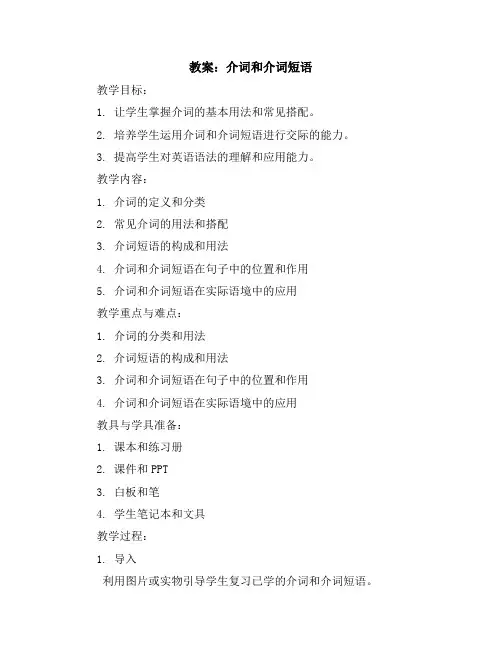
教案:介词和介词短语教学目标:1. 让学生掌握介词的基本用法和常见搭配。
2. 培养学生运用介词和介词短语进行交际的能力。
3. 提高学生对英语语法的理解和应用能力。
教学内容:1. 介词的定义和分类2. 常见介词的用法和搭配3. 介词短语的构成和用法4. 介词和介词短语在句子中的位置和作用5. 介词和介词短语在实际语境中的应用教学重点与难点:1. 介词的分类和用法2. 介词短语的构成和用法3. 介词和介词短语在句子中的位置和作用4. 介词和介词短语在实际语境中的应用教具与学具准备:1. 课本和练习册2. 课件和PPT3. 白板和笔4. 学生笔记本和文具教学过程:1. 导入利用图片或实物引导学生复习已学的介词和介词短语。
引导学生观察图片或实物,让学生尝试用介词和介词短语描述。
2. 课堂讲解讲解介词的定义和分类,举例说明。
讲解常见介词的用法和搭配,通过例句和练习进行巩固。
讲解介词短语的构成和用法,通过例句和练习进行巩固。
讲解介词和介词短语在句子中的位置和作用,通过例句和练习进行巩固。
讲解介词和介词短语在实际语境中的应用,通过例句和练习进行巩固。
3. 小组活动将学生分成小组,给每个小组一张图片或实物,让学生用介词和介词短语进行描述。
鼓励学生互相交流,分享自己的描述。
4. 课堂练习进行课堂练习,包括填空题、选择题和改错题,巩固学生对介词和介词短语的理解和应用。
回答学生的问题,进行解答和解释。
板书设计:1. 介词的定义和分类2. 常见介词的用法和搭配3. 介词短语的构成和用法4. 介词和介词短语在句子中的位置和作用5. 介词和介词短语在实际语境中的应用作业设计:1. 完成练习册上的相关练习题。
2. 用介词和介词短语描述自己家里的物品位置,写一篇小作文。
课后反思:本节课通过图片和实物引导学生复习已学的介词和介词短语,并通过讲解和练习进行巩固。
小组活动让学生积极参与,提高他们的口语表达能力。
课堂练习和作业设计帮助学生巩固所学知识,并提高他们的写作能力。
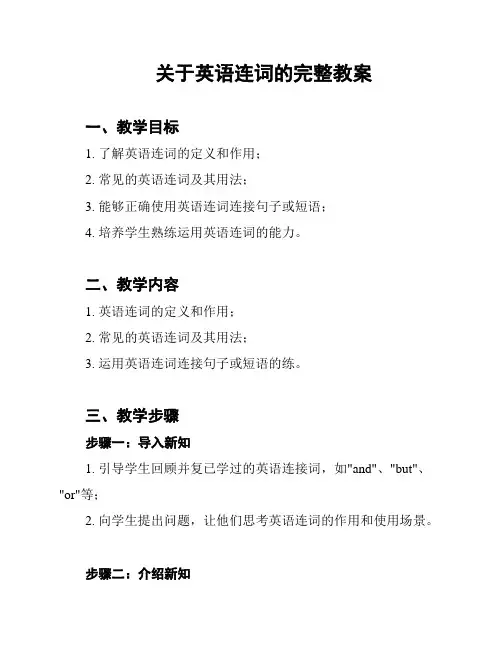
关于英语连词的完整教案
一、教学目标
1. 了解英语连词的定义和作用;
2. 常见的英语连词及其用法;
3. 能够正确使用英语连词连接句子或短语;
4. 培养学生熟练运用英语连词的能力。
二、教学内容
1. 英语连词的定义和作用;
2. 常见的英语连词及其用法;
3. 运用英语连词连接句子或短语的练。
三、教学步骤
步骤一:导入新知
1. 引导学生回顾并复已学过的英语连接词,如"and"、"but"、"or"等;
2. 向学生提出问题,让他们思考英语连词的作用和使用场景。
步骤二:介绍新知
1. 向学生介绍英语连词的定义:英语连词是用来连接句子、短语或单词的词语,起到连接和衔接的作用;
2. 分别介绍常见的英语连词及其用法,如"because"、"although"、"while"等;
3. 通过例句和语境让学生理解各个连词的具体用法和意义。
步骤三:练运用
1. 给学生分发练题,要求他们运用所学的英语连词连接句子或短语;
2. 鼓励学生在练中积极思考,互相交流,并及时纠正他们的错误;
3. 收集学生的作业,给予反馈和评价。
四、教学评价
1. 观察学生在课堂上的表现,包括对英语连词的理解和运用能力;
2. 收集学生的练作业,评价他们的语法准确性和句子连贯性;
3. 针对学生的情况,给予个别辅导和指导。
五、教学反思
1. 分析学生在英语连词过程中的常见问题和困难;
2. 总结教学方法的优点和不足,为今后的教学改进提供参考。
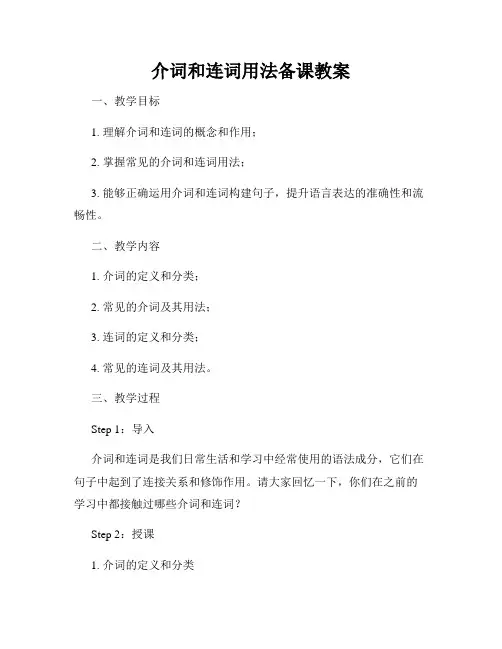
介词和连词用法备课教案一、教学目标1. 理解介词和连词的概念和作用;2. 掌握常见的介词和连词用法;3. 能够正确运用介词和连词构建句子,提升语言表达的准确性和流畅性。
二、教学内容1. 介词的定义和分类;2. 常见的介词及其用法;3. 连词的定义和分类;4. 常见的连词及其用法。
三、教学过程Step 1:导入介词和连词是我们日常生活和学习中经常使用的语法成分,它们在句子中起到了连接关系和修饰作用。
请大家回忆一下,你们在之前的学习中都接触过哪些介词和连词?Step 2:授课1. 介词的定义和分类- 介词是连接名词、代词、动词或者句子与其他成分的词语,用来表示时间、地点、方向、方式或者目的等关系。
- 常见的介词可以分为时间介词、地点介词、方式介词、目的介词等不同类别。
示例:- 时间介词:at, in, on- 地点介词:in, on, at, by- 方式介词:with, by, through- 目的介词:for, to2. 常见的介词及其用法- at:用于表示具体的时间点、地点或者价值,如at 2 o'clock, at school, at a reasonable price;- in:用于表示较大的时间段、地点或者范围,如in the morning, in the park, in this area;- on:用于表示某一天、日期、具体的表面或者媒介,如on Monday, on February 14th, on the table, on television;- by:用于表示通过某种方式、交通工具或者制定的时间,如by email, by bus, by 5 o'clock;- with:用于表示陪同、伴随或者具备某种方式,如with friends, with joy, with a pen.3. 连词的定义和分类- 连词用来连接词语、短语、从句或者句子,使其关系更加紧密。
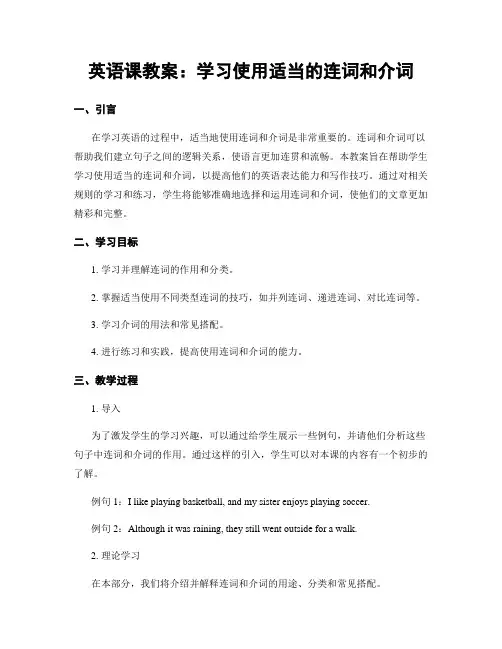
英语课教案:学习使用适当的连词和介词一、引言在学习英语的过程中,适当地使用连词和介词是非常重要的。
连词和介词可以帮助我们建立句子之间的逻辑关系,使语言更加连贯和流畅。
本教案旨在帮助学生学习使用适当的连词和介词,以提高他们的英语表达能力和写作技巧。
通过对相关规则的学习和练习,学生将能够准确地选择和运用连词和介词,使他们的文章更加精彩和完整。
二、学习目标1. 学习并理解连词的作用和分类。
2. 掌握适当使用不同类型连词的技巧,如并列连词、递进连词、对比连词等。
3. 学习介词的用法和常见搭配。
4. 进行练习和实践,提高使用连词和介词的能力。
三、教学过程1. 导入为了激发学生的学习兴趣,可以通过给学生展示一些例句,并请他们分析这些句子中连词和介词的作用。
通过这样的引入,学生可以对本课的内容有一个初步的了解。
例句1:I like playing basketball, and my sister enjoys playing soccer.例句2:Although it was raining, they still went outside for a walk.2. 理论学习在本部分,我们将介绍并解释连词和介词的用途、分类和常见搭配。
2.1 连词2.1.1 并列连词并列连词用于连接并列的词组、句子或句子成分。
常见的并列连词有and、but、or等。
例如:- I like apples and oranges.- I wanted to go to the movies, but I had to study for the exam.- You can have coffee or tea.2.1.2 递进连词递进连词用于表示递进关系或添加信息。
常见的递进连词有and、besides、moreover等。
例如:- He is smart and hardworking.- Besides English, she can speak Spanish.- Moreover, he has a lot of experience in this field.2.1.3 对比连词对比连词用于表示对比关系,让读者明确两个事物之间的差异。
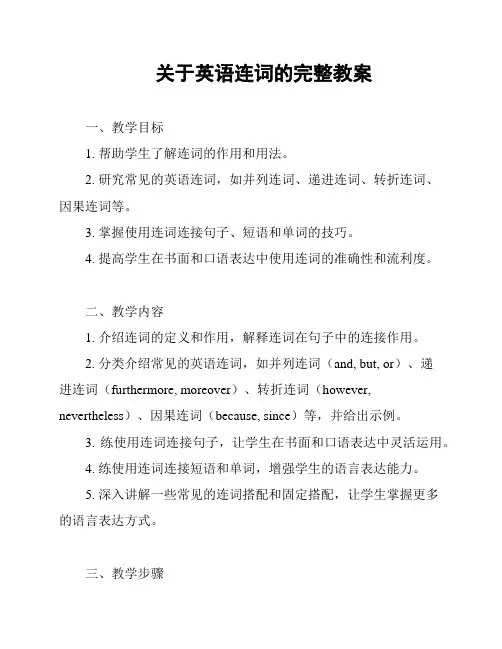
关于英语连词的完整教案一、教学目标1. 帮助学生了解连词的作用和用法。
2. 研究常见的英语连词,如并列连词、递进连词、转折连词、因果连词等。
3. 掌握使用连词连接句子、短语和单词的技巧。
4. 提高学生在书面和口语表达中使用连词的准确性和流利度。
二、教学内容1. 介绍连词的定义和作用,解释连词在句子中的连接作用。
2. 分类介绍常见的英语连词,如并列连词(and, but, or)、递进连词(furthermore, moreover)、转折连词(however, nevertheless)、因果连词(because, since)等,并给出示例。
3. 练使用连词连接句子,让学生在书面和口语表达中灵活运用。
4. 练使用连词连接短语和单词,增强学生的语言表达能力。
5. 深入讲解一些常见的连词搭配和固定搭配,让学生掌握更多的语言表达方式。
三、教学步骤1. 引入连词的概念,与学生互动讨论连词的作用和意义。
2. 分类介绍常见的英语连词,通过示例句子让学生理解其用法。
3. 练使用连词连接句子,进行口语和书面表达训练。
4. 练使用连词连接短语和单词,进行语言表达能力的提升。
5. 深入讲解一些常见的连词搭配和固定搭配,让学生丰富语言表达方式的同时增加词汇量。
四、教学评估1. 课堂练:通过口语和书面练,检查学生对连词的理解和运用能力。
2. 小组合作:设计小组活动,让学生在团队中运用连词进行合作交流。
3. 个人作业:布置书面作业,让学生独立完成使用连词连接句子的任务。
五、教学资源1. 教材:根据教学内容编写的教材,包括连词的定义、用法和练题。
2. 示例句子:提供多个示例句子以帮助学生理解和记忆连词的用法。
3. 练题:编写的口语和书面练题,用于检测学生的掌握程度。
六、教学反思1. 教学过程中,要注重让学生参与互动,提高他们的研究兴趣和积极性。
2. 针对学生的不同水平和需求,灵活调整教学内容和活动,确保每个学生都能得到有效的研究。
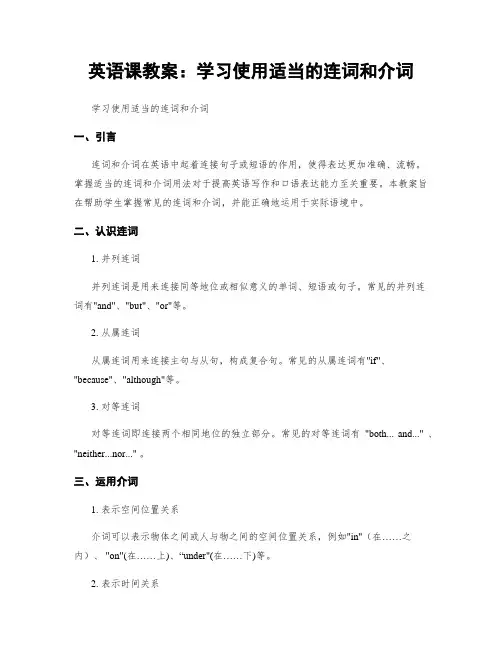
英语课教案:学习使用适当的连词和介词学习使用适当的连词和介词一、引言连词和介词在英语中起着连接句子或短语的作用,使得表达更加准确、流畅。
掌握适当的连词和介词用法对于提高英语写作和口语表达能力至关重要。
本教案旨在帮助学生掌握常见的连词和介词,并能正确地运用于实际语境中。
二、认识连词1. 并列连词并列连词是用来连接同等地位或相似意义的单词、短语或句子。
常见的并列连词有"and"、"but"、"or"等。
2. 从属连词从属连词用来连接主句与从句,构成复合句。
常见的从属连词有"if"、"because"、"although"等。
3. 对等连词对等连词即连接两个相同地位的独立部分。
常见的对等连词有"both... and..." 、"neither...nor..." 。
三、运用介词1. 表示空间位置关系介词可以表示物体之间或人与物之间的空间位置关系,例如"in"(在……之内)、 "on"(在……上)、“under"(在……下)等。
2. 表示时间关系介词还可以用来表示时间关系,例如"at"(在……时刻)、 "during"(在……期间)和"in"(在……之内)等。
3. 表示目的或原因介词也可以表示目的或原因,例如 "for"(为了)、 "because of"(因为)和"due to"(由于)等。
四、练习与应用1. 连词练习请根据下面的句子,在括号中选择适当的连词填空。
1) I love reading books ______ I can learn new things.a) but b) and c) or2) He is very rich, ______ he doesn't talk about it.a) yet b) so c) or3) ______ you work hard, you will succeed.a) If b) Because c) Although答案: 1)b 2)a 3)c2. 介词运用请填入适当的介词,使得句子意思完整。
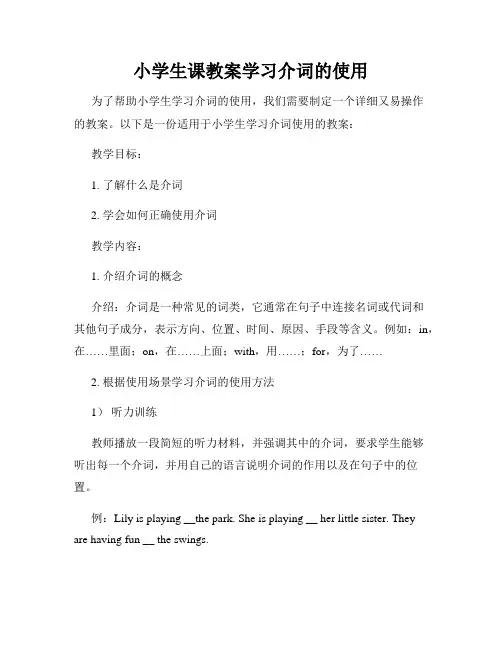
小学生课教案学习介词的使用为了帮助小学生学习介词的使用,我们需要制定一个详细又易操作的教案。
以下是一份适用于小学生学习介词使用的教案:教学目标:1. 了解什么是介词2. 学会如何正确使用介词教学内容:1. 介绍介词的概念介绍:介词是一种常见的词类,它通常在句子中连接名词或代词和其他句子成分,表示方向、位置、时间、原因、手段等含义。
例如:in,在……里面;on,在……上面;with,用……;for,为了……2. 根据使用场景学习介词的使用方法1)听力训练教师播放一段简短的听力材料,并强调其中的介词,要求学生能够听出每一个介词,并用自己的语言说明介词的作用以及在句子中的位置。
例:Lily is playing __the park. She is playing __ her little sister. Theyare having fun __ the swings.解析:这个材料中出现了三个介词:at、with、on。
介词at表示位置,with表示手段,on表示在上面。
在介绍完这三个介词的基本意思后,让学生用自己的语言描述这三个介词的具体作用。
2)词语搭配练习在黑板上列出一些常见的介词词组,例如:in front of、at the back of、on top of、underneath 等,并要求学生以小组为单位,在5分钟之内使用这些介词词组造句。
例句:1. The cat is sleeping on top of the bookshelf.2. The students are sitting in front of the teacher's desk.3. The ball is underneath the table.3. 课堂练习设计一个练习册,包括简短的介词使用题目。
为了让学生更加深刻的掌握在句子中使用介词的技巧,可以让学生进行小组内或者小组间的比赛,比赛结束后,提供答案,让学生进行自我矫正和评价,最后得出小组或者个人的得分。
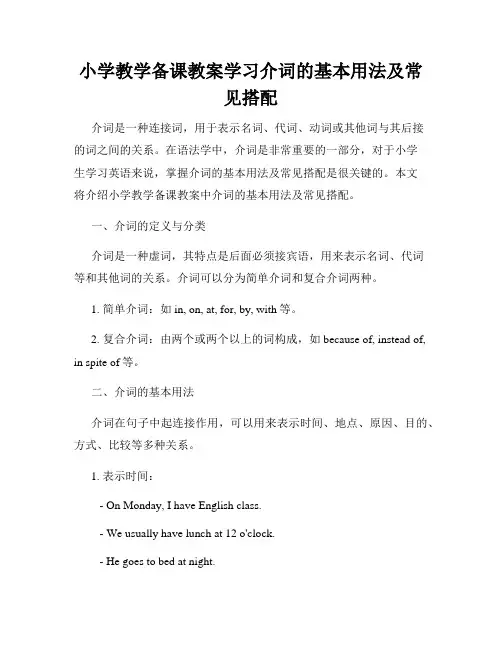
小学教学备课教案学习介词的基本用法及常见搭配介词是一种连接词,用于表示名词、代词、动词或其他词与其后接的词之间的关系。
在语法学中,介词是非常重要的一部分,对于小学生学习英语来说,掌握介词的基本用法及常见搭配是很关键的。
本文将介绍小学教学备课教案中介词的基本用法及常见搭配。
一、介词的定义与分类介词是一种虚词,其特点是后面必须接宾语,用来表示名词、代词等和其他词的关系。
介词可以分为简单介词和复合介词两种。
1. 简单介词:如in, on, at, for, by, with等。
2. 复合介词:由两个或两个以上的词构成,如because of, instead of, in spite of等。
二、介词的基本用法介词在句子中起连接作用,可以用来表示时间、地点、原因、目的、方式、比较等多种关系。
1. 表示时间:- On Monday, I have English class.- We usually have lunch at 12 o'clock.- He goes to bed at night.2. 表示地点:- The book is on the table.- The cat is under the chair.- We can meet at the park.3. 表示原因:- She is crying because of the sad movie.- I couldn't go to the party due to my illness.4. 表示目的:- I go to school to study.- He bought a gift for his mother.5. 表示方式:- She speaks with a smile.- They solved the problem by working together.6. 表示比较:- He is taller than his sister.- She is better at English than math.三、介词的常见搭配介词搭配是指介词与其他词的组合使用。
小学教学备课教案学习常见连词和介词连词和介词是语法学习中的关键部分,它们能够帮助我们在句子中正确地连接词语和短语,使话语更加流畅。
在小学教学备课教案中,学习常见的连词和介词对于提升学生的语言表达能力和语言逻辑思维能力具有重要作用。
本文将介绍一些常见的连词和介词及其用法。
一、连词1. 并列连词并列连词用于连接并列的词、短语或句子。
在编写小学教学备课教案时,使用并列连词可以帮助学生正确表达多个事物或观点的关系。
例如:- 连词"和"用于连接两个并列的词语,如"苹果和橙子"。
- 连词"或"用于表示选择,如"喜欢吃苹果或橙子"。
- 连词"但是"用于表示对比,如"我喜欢苹果,但是我不喜欢橙子"。
2. 时间连词时间连词用于表示时间关系,有助于帮助学生正确描述事件的发生顺序和时间间隔。
例如:- 连词"先"用于表示先后顺序,如"先吃早饭,然后去学校"。
- 连词"后来"用于表示事情发生的时间晚于之前的时间,如"我先吃早饭,后来去学校"。
3. 原因连词原因连词用于表示结果与原因之间的逻辑关系。
在小学教学备课教案中,使用原因连词能够帮助学生正确表达事物之间的因果关系。
例如:- 连词"因为"用于表示原因,如"他迟到了,因为起晚了"。
- 连词"所以"用于表示结果,如"他起晚了,所以迟到了"。
二、介词介词用于连接名词(或名词短语)与其他成分,它们能够帮助学生正确描述事物的位置、关系和方式。
1. 地点介词地点介词用于描述事物的位置关系,可以帮助学生描述物体在空间中的位置。
例如:- 介词"in"表示在某个地方,如"他在教室里"。
认识介词和连词教学目标:1. 让学生了解什么是介词和连词,并能正确使用它们。
2. 帮助学生理解介词和连词在句子中的作用和功能。
3. 培养学生对介词和连词用法的掌握能力。
教学内容:1. 介词的定义和分类2. 介词短语的构成和用法3. 连词的定义和分类4. 连词在句子中的作用和连接功能教学步骤:一、导入(5分钟)1. 教师向学生介绍“介词”和“连词”的概念,并给出一些例子。
2. 教师提问学生是否了解介词和连词的作用。
二、学习介词(15分钟)1. 教师通过PPT或黑板向学生展示介词的定义,并对常见的介词进行分类和解释。
2. 教师给学生提供一些例子,让学生找出这些句子中的介词,并解释介词在这些句子中的作用。
3. 学生进行小组讨论,分享自己找到的例子和解释。
三、学习介词短语(15分钟)1. 教师介绍介词短语的构成和用法,并给学生提供一些例子。
2. 学生进行小组练习,根据给定的句子写出其中的介词短语,并解释介词短语在这些句子中的作用。
3. 学生进行小组展示,分享自己的答案和解释。
四、学习连词(15分钟)1. 教师通过PPT或黑板向学生展示连词的定义,并对常见的连词进行分类和解释。
2. 教师给学生提供一些例子,让学生找出这些句子中的连词,并解释连词在这些句子中的连接作用。
3. 学生进行小组讨论,分享自己找到的例子和解释。
五、总结与拓展(10分钟)1. 教师与学生一起总结介词和连词的定义、分类和作用,并提醒学生注意其用法。
2. 教师提供一些补充练习题供学生巩固和拓展所学知识。
3. 学生进行个人练习,完成练习题并交互讨论解答。
六、作业布置(5分钟)1. 教师布置相关的作业,要求学生运用所学的介词和连词写一篇200字的短文。
2. 教师解答学生提出的问题并进行相关的补充说明。
七、教学反思(5分钟)教师进行教学反思,回顾教学过程,总结教学效果。
对学生在学习中的表现进行评价和指导。
教学资源:1. PPT或黑板2. 教材和练习题3. 学生课本和笔记教学评价方法:1. 教师观察学生的课堂参与情况和回答问题的能力。
小学英语语法教案-连词及运用简介本教案主要介绍小学英语中的连词以及它们的运用方法。
通过研究本教案,学生们能够掌握基础的英语语法知识,更好地理解英语的句子结构,提高英语写作水平。
教学内容1. 连词的定义和分类* 连词的作用* 连词的分类:并列连词、从属连词、并列从属连词2. 并列连词的用法* 连接并列的主语* 连接并列的谓语动词* 连接并列的宾语* 连接并列的状语3. 从属连词的用法* 引导名词性从句* 引导形容词性从句* 引导副词性从句4. 并列从属连词的用法5. 连词的练教学目标1. 了解连词的定义和分类;2. 掌握并列连词、从属连词、并列从属连词的用法;3. 能够正确运用连词连接句子;4. 培养学生的英语语感和英语写作水平。
教学准备1. 教材:小学英语教材;2. 课件:连词的PPT课件。
教学过程1. 导入新课* 介绍本课的主题:连词及其运用;* 引入连词的定义和作用。
2. 讲解连词的分类和用法* 分类:并列连词、从属连词、并列从属连词;* 并列连词的用法;* 从属连词的用法;* 并列从属连词的用法。
3. 练连词的用法* 巩固并列连词、从属连词、并列从属连词的运用;* 通过练,将所学语法知识应用到实际写作中。
4. 总结* 请学生总结本课学到的连词知识,并提出疑问;* 解答学生提出的问题。
课后作业1. 完成练册中的相关题目;2. 阅读英文文章,寻找其中的并列连词和从属连词;3. 自己动手写几个句子,运用所学的并列连词和从属连词。
小结通过本课的学习,学生们能够掌握基础的连词知识,为以后的英语语法学习奠定基础。
在教学中,需要注重实践应用,并随时帮助学生解决问题,以提高教学效果。
小学英语连词教案教案标题:小学英语连词教案教学目标:1. 通过本节课的学习,学生能够理解并正确使用一些常见的英语连词。
2. 学生能够在句子中正确运用这些连词,使句子更加连贯和完整。
3. 学生通过活动和练习,培养合作意识和沟通能力。
教学重点:1. 让学生正确理解各种英语连词的意思和用法。
2. 培养学生运用所学连词组成句子的能力。
教学难点:学生能够灵活地选择合适的连词并在句子中正确运用。
教学准备:1. 小黑板/白板和彩色粉笔/白板笔。
2. 多媒体课件或相关图片。
3. 单词卡片或图片卡片。
教学过程:步骤一:导入(5分钟)1. 引入本节课的话题,通过问问题或展示图片激发学生对连词的兴趣和认知。
2. 准备一些与连词相关的常见词汇卡片或图片,让学生观察并尽可能说出与连词相关的词汇。
步骤二:教学(15分钟)1. 通过多媒体课件或黑板上的示意图,介绍和解释一些常见的英语连词,如and, but, or等。
2. 针对每个连词,提供简单的例句和情境,帮助学生理解其意思和用法。
3. 让学生跟读和模仿示例句子,并强调连词的使用位置。
步骤三:练习(20分钟)1. 组织学生进行连词操练,可以使用填空、配对或完成句子等形式。
2. 分发练习材料,让学生根据提示选择合适的连词填空,并完成句子。
教师可以设定不同难度级别的任务,以满足不同学生的需求。
3. 在练习过程中,鼓励学生互相合作讨论,并及时给予正确的反馈和指导。
步骤四:巩固(10分钟)1. 邀请学生在组内进行小组讨论,共同编写一些包含连词的对话或故事。
2. 随机抽取几组学生分享他们的作品,并对其进行评价和指导。
步骤五:总结与拓展(5分钟)1. 学生回顾本节课所学的连词,并总结其基本用法和应用场景。
2. 鼓励学生理解连词在句子中的作用,并拓展运用到更多的语言表达中。
教学反思:教案设置让学生通过多样的教学手段进行连词的学习和运用,既注重基础的理解,也强调语言的实际运用能力。
同时通过合作讨论和小组活动,培养学生的合作意识和沟通能力。
小学三年级教案学习介词与连词的用法小学三年级教案:学习介词与连词的用法引言:本教案旨在帮助小学三年级的学生掌握介词与连词的正确用法。
通过针对性的教学活动,使学生能够准确运用介词与连词,提高语言表达的准确性和连贯性。
本教案设计了一系列的活动,旨在激发学生的学习兴趣,培养学生的语言学习能力。
教学目标:1. 学习并掌握常用的介词,并能准确运用在句子中。
2. 学习并掌握常用的连词,并能正确使用在句子中。
3. 培养学生观察、思考和分析的能力,提高语言组织和表达的能力。
教学内容:一、介词的基本概念和用法1. 通过图片、实物等多种形式展示不同的介词,并引导学生观察和思考介词的功能和作用。
2. 分组活动:将学生分成小组,让每个小组选择一种介词,用所选的介词来描述图片或实物。
并鼓励学生举手发表自己的意见。
3. 小组讨论:让学生用介词为句子填空,提高学生的语法意识和句子结构的准确性。
二、常用的介词及其用法1. 通过幻灯片和例句的方式,介绍常用的介词,并解释其常见的用法和搭配。
2. 练习活动:让学生根据所学的介词,完成填空题或根据提示写出完整句子。
3. 情景操练:设计一些情景,让学生根据所给情景和信息,使用正确的介词进行表达。
三、连词的基本概念和用法1. 通过示范和解释,介绍常用的连词的用法和功能,例如并列连词、递进连词、转折连词等。
2. 讨论活动:给学生不完整的句子,让他们根据所学的连词补全句子,提高语句的连贯性和逻辑性。
并请学生举手发表自己的答案和理由。
3. 小组合作:将学生分成小组,要求他们合作完成一篇短文,短文中要使用所学的连词,并要求短文的内容连贯、主题清晰。
四、常用的连词及其用法1. 通过演示和练习,让学生熟悉并掌握常用的连词,如“因为”、“所以”、“但是”等,帮助学生理解它们在句子中的作用和用法。
2. 练习活动:让学生根据所给句子,选择正确的连词填空,并解释答案的理由。
3. 句子创作:让学生根据所学的连词和素材,创作一些有逻辑关系的句子,鼓励学生运用创造性思维。
腾飞辅导中心小学英语语法(第22期)第四讲介词和连词Name Mark ★重点讲解一、介词的用法(一)时间介词(1)at①表示具体的时刻:at seven (o’clock )②表示人的年龄:at the age of eleven③表示一段时间,“在...... 期间”:at night (在夜里)at Christmas(在圣诞期间)④与结尾为festival的节日连用,如:at Spring Festival(2)in:表示一段时间,常与月份和季节连用,也可用在习惯用语中。
如:in spring in January in February in the morning (3)on:表示具体的某一天,常与day和表示星期、节日的词连用。
如:on October the tenth on Christmas Eve on Christmas Dayon a cold day on Wednes day on Tree Planting Day (4)before 和after:表示时间的先后顺序。
如:They have to finish the work before Thursday.The boys often play football after dinner.We sometimes take a walk after supper.(5)from ... to ...:“从...... 到......”。
如:We have classes from Monday to Friday.She worked in the garden from morning to evening.This train is from Beijing to Tianjin.(二)方位介词(1)on :“在..... 上面” ,两物体有接触。
(2)over:“在..... 正上方” ,两物体没有接触。
如:A lamp is over the table. (灯和桌面没有接触)(3)above :“在..... 斜上方” ,两物体没有接触。
如:The plane is flying above the clouds. (飞机在云层中飞行)(4)under 和below:在..... 下面,两物体有接触。
①under :“在...... 的正下方” 。
如:There is a cat under the table.②below:“在...... 的下面”,不强调是否在正下方。
如:Our classroom is below theirs. (我们的教室在他们教室的下面)(5)in:“在...... 里面或者在 ...... 地方(大地点)” 。
如:in the drawer in the box in the room in the zooA group of visitors arrived in Beijing yesterday. (一群游人昨天抵达了北京)(6)at:“在...... 旁边或者在...... 地方(小地点)” 。
如:The family is eating at the table.(一家人正坐在桌子旁吃饭)I met Peter at the railway station.(7)behind:“在...... 后面” 。
如:Sally hid herself behind a tree.in front of“在... 外部的... 前面” 。
如:There is an apple tree in front of the houseThere is a house behind the apple tree.in the front of “在... 内部的... 前面” 。
如:There is a blackboard in the front of the classroom.(8)between:“在两者之间” 。
如:The office building is between the swimming pool and the playing ground. (三)动向介词(1)across :“横穿”,常与street ,bridge等名词连用。
如:Go across the street, and you will find a book shop.(2)though:“从....... 里面穿过” 。
如:We walked through the woods. (森林)(3)along :“沿着...... ”,常与road ,street ,river等名词连用。
如:Dick and Wendy walked along the river.Go along the road, and then turn left.(四)表示方式、手段的介词(1)by:表示“靠...... ;用......” 。
如:by bus by painting(靠画画为生)(2)with:表示“使用...... ” 。
如:We write with a pen. with our right hands with knives and forks (用刀和叉)(3)in:“用....... 语言” 。
如:We talked in English.(五)其它介词的用法(1)for①表示目的、对象,意思为“为......” 。
如:I have a gift for you. (给你)②表示原因,意思为“因为” 。
如:Thank you for your dinner. (感谢你的款待)I am sorry for being late. (对不起,我来晚了。
)(2)about:表示某种事物的内容,意思是“关于” 。
如:The movie is about the history of China. (这是一本关于中国历史的书)(3)with :①表示“和...... 一起” 。
如:Can you play with me? (你能跟我一起玩吗?)I did some cleaning with my mother at weekends. (周末我和妈妈一起做清洁)②表示“对于...... ” 。
如:I am very strict with my students. (be strict with ...对某人严格要求)③表示人或物具有的性质或特点,意思是“带着、带有” 。
如:The girl with red hair is my sister. (红头发的女孩是我妹妹)a woman with sunglasses(带着太阳镜的妇女)Our teacher came into the classroom with some flowers in her hand.(4)in:表示“穿着,带着” 。
如:The boy in blue is my brother.a boy in a white shirt a boy in a black hat(5)like:“像......” 。
如:John is like his father.John looks like an actor. (约翰看起来像一位演员)(6)of:表示所属关系,意思是“......的” (名词所有格)。
二、连词连词:是用来连接两个词或句子的词。
1.and: 和、还有,表示叠加关系。
Jimmy and me are classmates.2.or:还是,表示选择关系。
Which do you like, panda or monkey?3.but:但是,表示转折关系。
I like football, but I like basketball more.4.when:当......时,用来连接两个句子。
I was sad when I saw the broken tree.5.while:当......时,用来连接两个句子。
My mum is watching TV while I am doing homework.6.before:在.....之前,Sally went away before I came back.7.after:在......之后,I watch TV after I finish my homework.8.because:因为......,表示原因。
She is not here, because she’s ill.9.so:所以、那么......,表示结果。
He works very hard, so he gets 100.10.if:如果,表示条件假设。
I will go to the moon if I can fly.★做中学一、单项选择( ) 1.______ the afternoon of May, we visited the old man.A. OnB. AtC. In( ) 2.He left home _______ a cold winter evening.A. atB. onC. in( ) 3.Shanghai is _______ the east of China.A. inB. onC. to( ) 4.________ my father’s help, I have finished my composition.A. UnderB. OnC. with( ) 5.I really can’t agree _______ you.A. toB. onC. with( ) 6.How about ________ the flowers now?A. wateringB. are wateringC. watered( ) 7.What will you have ________ breakfast this morning?A. withB. forC. by( ) 8.A plane is flying ________ the city.A. onB. overC. above( ) 9.You are free to speak _______ the meeting.A. atB. inC. on( ) 10.Mr. Green stayed in China _______ Friday.A. toB. onC. till( ) 11.I won’t ask about it, I’m going to see it ____ _ my own eyes.A. byB. forC. with( ) 12.We go to school every day _ ______ Sunday.A. exceptB. withoutC. on( ) 13.There is a small river ___ the two townsA. inB. betweenC. among( ) 14.Are you going to the zoo __ __ _ bus or ___ my car?A. on; byB. by; inC. on; in( ) 15. We traveled overnight to Paris and arrived _______ 5 o’clock ______ the morning.A. on; inB. at; inC. at; onD. in; on( ) 16.There is many apples ___ the tree. A bird ___ the tree is picking an apple.A. in; onB. on; inC. in; at二、从方框中选择正确的连词填空。